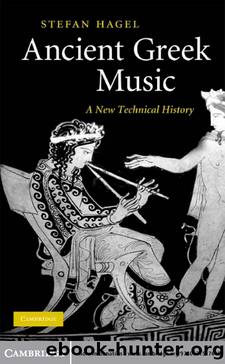Ancient Greek Music by Stefan Hagel

Author:Stefan Hagel
Language: eng
Format: epub
Publisher: CAMBRIDGE UNIVERSITY PRESS
Published: 2010-07-14T16:00:00+00:00
Table 7 Harmonic context of Lydian paramésē
This method can help us in detecting various modal characteristics of Lydian pieces. For the present, however, we concentrate on the question of paramésē. Of all intervals that this note forms with others, only one shows a significant variation from what we would expect: fifths between hypátē ˚˝ and paramésē are obviously avoided.16 This substantiates the suspicion that the Lydian paramésē of the Roman era did no longer conform to Philolaus’ harmonía with its compulsory resonance between hypátē and paramésē. Interestingly, the extraordinarily high frequency of major thirds between diátonos and paramésē itself is not due to a significant deviation from the expectation, but sufficiently explained by the predilection for these notes and for melodic thirds. Even so, its dominance can be regarded as a potential factor in determining the fine tuning.
A closer look at the sources further confirms the picture. Table 7 lists all Lydian fragments that contain any of the relevant melodic progressions from or to paramésē. The transition from Hellenistic to Roman times is characterised by replacement of chromatic with diatonic music. In strictly chromatic Lydian, both and are naturally missing, so that the absence of their combination with paramésē in the earlier style is trivial.17
Download
This site does not store any files on its server. We only index and link to content provided by other sites. Please contact the content providers to delete copyright contents if any and email us, we'll remove relevant links or contents immediately.
The Lost Pianos of Siberia by Sophy Roberts(467)
Harnessed: How Language and Music Mimicked Nature and Transformed Ape to Man by Mark Changizi(397)
Weird Al: The Book by Rabin Nathan & Yankovic Al(388)
Murder Rap: The Untold Story of the Biggie Smalls and Tupac Shakur Murder Investigations by Kading Greg(384)
The Man Who Japed by Dick Philip K(380)
The Road to Woodstock by Michael Lang(379)
Inside Conducting by Christopher Seaman(378)
Music and The Mind by Anthony Storr(367)
This Has All Been Wonderful: A Travel Monologue from Summer 1994, the Year Phish Became Phish by David Steinberg(336)
Beatleness by Leonard Candy(333)
Androids in the Enlightenment by Voskuhl Adelheid;(328)
The Rest Is Noise by Alex Ross(327)
The Rest is Noise: Listening to the Twentieth Century by Ross Alex(281)
From 1989, or European Music and the Modernist Unconscious by Brodsky Seth(279)
The Common People of Ancient Rome by Frank Frost Abbott(272)
Lost Transmissions by Desirina Boskovich(249)
More Fun in the New World by John Doe & Tom Desavia(246)
Ancient Greek Music by Stefan Hagel(246)
Salomè by Salome(240)
